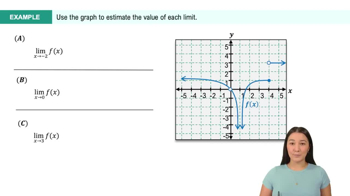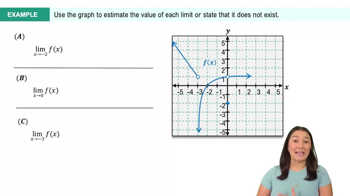Table of contents
- 0. Functions7h 52m
- Introduction to Functions16m
- Piecewise Functions10m
- Properties of Functions9m
- Common Functions1h 8m
- Transformations5m
- Combining Functions27m
- Exponent rules32m
- Exponential Functions28m
- Logarithmic Functions24m
- Properties of Logarithms34m
- Exponential & Logarithmic Equations35m
- Introduction to Trigonometric Functions38m
- Graphs of Trigonometric Functions44m
- Trigonometric Identities47m
- Inverse Trigonometric Functions48m
- 1. Limits and Continuity2h 2m
- 2. Intro to Derivatives1h 33m
- 3. Techniques of Differentiation3h 18m
- 4. Applications of Derivatives2h 38m
- 5. Graphical Applications of Derivatives6h 2m
- 6. Derivatives of Inverse, Exponential, & Logarithmic Functions2h 37m
- 7. Antiderivatives & Indefinite Integrals1h 26m
1. Limits and Continuity
Introduction to Limits
Problem 2.4.56
Textbook Question
Find polynomials p and q such that f=p/q is undefined at 1 and 2, but f has a vertical asymptote only at 2. Sketch a graph of your function.
 Verified step by step guidance
Verified step by step guidance1
Step 1: Understand the problem requirements. We need to find polynomials p(x) and q(x) such that the rational function f(x) = \frac{p(x)}{q(x)} is undefined at x = 1 and x = 2, but has a vertical asymptote only at x = 2.
Step 2: Recall that a rational function is undefined where its denominator is zero. To make f(x) undefined at x = 1 and x = 2, q(x) should have factors (x - 1) and (x - 2).
Step 3: To ensure a vertical asymptote at x = 2, the factor (x - 2) should not be canceled out by the numerator p(x). Therefore, p(x) should not have the factor (x - 2).
Step 4: To make f(x) defined at x = 1, the factor (x - 1) in q(x) should be canceled by a similar factor in p(x). Thus, p(x) should have the factor (x - 1).
Step 5: Construct the polynomials. Let p(x) = (x - 1) and q(x) = (x - 1)(x - 2). This ensures f(x) = \frac{(x - 1)}{(x - 1)(x - 2)} is undefined at x = 1 and 2, but has a vertical asymptote only at x = 2.
Recommended similar problem, with video answer:
 Verified Solution
Verified SolutionThis video solution was recommended by our tutors as helpful for the problem above
Video duration:
5mPlay a video:
Was this helpful?

 6:47m
6:47mWatch next
Master Finding Limits Numerically and Graphically with a bite sized video explanation from Callie
Start learning





